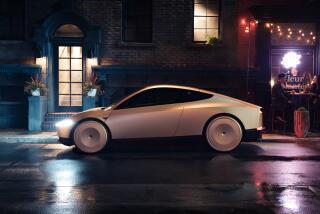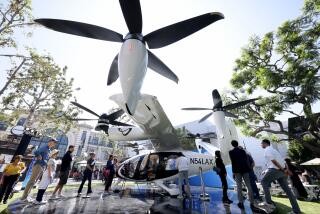Can We Ever Commute as Jetsons Did?
- Share via
Science was seen as the answer to many problems in the years after World War II. So it seemed inevitable that commuters would soon be freed from their cars and become airborne. The February 1951 cover of Popular Mechanics, for example, depicts a helicopter in a suburban garage -- a vision of America’s future.
For many technological and economic reasons, it didn’t happen, and freeways grow more crowded by the day. But the dream remains alive for a small but determined group of engineers, computer scientists and aerospace visionaries who foresee a new era of flight that will make congested freeways a 20th century anachronism.
“One day, ‘The Jetsons’ could be the answer” to our traffic woes, said aircraft design engineer Sid Siddiqi, referring to the 1960s cartoon series featuring a suburban future full of flying cars. Siddiqi works for the National Consortium for Aviation Mobility, a Virginia-based nonprofit that is working with NASA to develop its Small Aircraft Transportation System -- technology that could serve as a precursor to the long-envisioned “highway in the sky.”
Another pursuer of the dream is Paul Moller of Davis, who has spent 40 years -- and millions of dollars -- trying to leave his own mark on aviation history. Moller, 67, has devoted his life to the Skycar, a personal aircraft that he believes could replace the automobile. “People say I’m nuts, and maybe I am. But I’m looking for something that will change mass transportation as we know it.”
It’s an idea that’s nearly as old as the Wright brothers’ first flight near Kitty Hawk 100 years ago this month, a utopian idea that gained steam after World War II, yielded to the nation’s car culture and is now back because of advances in aerospace and computer science.
Not that replicating the Jetsons’ commute will be easy. The U.S. Patent Office is home to dozens of ideas that underscore the enduring -- and so far fruitless -- quest for a mass-produced flying car.
Among the first was the Autoplane, built by the Curtiss Aeroplane Co. and unveiled at the 1917 Pan-American Aeronautic Exposition in New York City. With three wings and a rear propeller powered by the car’s engine, the Autoplane was billed as an “aerial limousine.” But this limo hopped more than it flew, and the idea was soon abandoned.
Plenty of early prototypes never got off the ground. Some that did crashed, killing the pilot -- and the idea.
“These ideas never panned out because of the expense and complexity of the crafts -- and sometimes because the idea itself was not very bright,” said Bob Van der Linden, curator of the Smithsonian National Air and Space Museum in Washington.
In 1950, the Fulton Airphibian became the first auto-plane hybrid certified for use by the Civil Aviation Administration. With removable wings, tail and propeller, the Airphibian cruised at 110 mph in the air and 55 mph on the ground. Prototypes logged 200,000 miles. But when investors got cold feet, plans to market the craft were scrapped.
Moulton Taylor, a former Navy pilot who started an aircraft manufacturing business in Washington state after the war, pursued a similar project. Frustrated by the five-hour drive between Seattle and Portland in the years before the interstate system, Taylor built the Aerocar, a craft that could be reconfigured from a plane into a car in 15 minutes and make the trip in an hour and a half.
The Aerocar looks like the result of a rear-end collision between a puddle jumper and an old Datsun, with the plane’s wings and tail sticking out of the trunk.
The Aerocar came close to being mass-produced. Ford considered it as late as the early 1970s.
But a variety of issues conspired to bring down Taylor’s dream. Construction of the interstate system hurt projected sales. The Aerocar’s projected retail price -- as much as $14,000 in early 1960s dollars -- was prohibitive. When the federal government started to regulate auto safety in the mid-’60s, the lightweight Aerocar was doomed.
“It’s difficult to get the airplane to be as light as it needs to be to fly and at the same time to make the automobile heavy enough to be safe on the road,” said Jake Schultz, a technical analyst for Boeing Co. who is writing a book about Taylor and the Aerocar.
Today, the obstacles to a society dominated by personal aircraft are so vast and complex that they make Icarus’ brush with the sun seem like a minor miscalculation.
To accommodate millions of vehicles zipping through the sky at high speeds, the nation’s air traffic control system would need to be revamped, and largely automated. The craft themselves would need to be virtually auto-piloted -- enter a destination, and off you go. No pilot’s license necessary.
Some, like the Smithsonian’s Van der Linden, don’t see it happening.
“It’s possible, but I wouldn’t hold my breath. These things have been said before,” the aviation historian said. “Can you imagine the average driver on an L.A. freeway in an airplane overhead? What a frightening experience that would be.”
But Siddiqi of the National Consortium for Aviation Mobility says the core technology that would allow for such automation is already available -- and advancing daily.
“I don’t see why someday a 16-year-old or a grandmother couldn’t do it,” said Siddiqi, who estimates that at least 20 entrepreneurs nationwide are trying to develop a personal aircraft. “We could do it, technology-wise, but not at a cost that Middle America could afford. Innovation is always at the mercy of the business side of things.”
And there’s still some aircraft engineering that needs to be done. Developing a quiet, reliable engine that allows for vertical takeoff -- and is affordable -- is the Holy Grail of those who dream of highways in the sky.
It’s the goal of Moller’s publicly traded company in Davis, where the four-passenger M400 Skycar prototype is powered by lightweight rotary engines.
Next year, Moller plans to flight-test a more powerful engine that would improve the Skycar’s performance and reliability. He is committed: For decades, he has helped fund his project with teaching gigs, developing real estate, even making organic almond butter and selling it on EBay. And he’s confident: The engine’s success could entice the kind of deep-pocketed investment partner he needs.
Still, he’s going to test-fly the Skycar’s new engine next year over a lake.
“With the lake, I feel more comfortable,” Moller said. “I just want to be around afterward if something goes wrong.”
More to Read
Inside the business of entertainment
The Wide Shot brings you news, analysis and insights on everything from streaming wars to production — and what it all means for the future.
You may occasionally receive promotional content from the Los Angeles Times.










